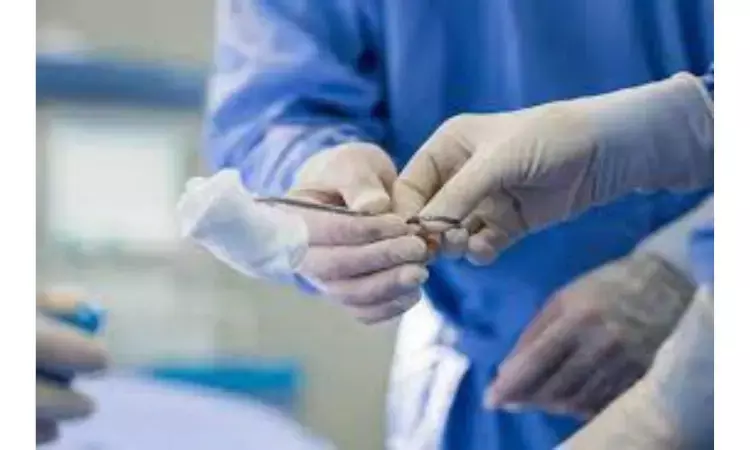- Home
- Medical news & Guidelines
- Anesthesiology
- Cardiology and CTVS
- Critical Care
- Dentistry
- Dermatology
- Diabetes and Endocrinology
- ENT
- Gastroenterology
- Medicine
- Nephrology
- Neurology
- Obstretics-Gynaecology
- Oncology
- Ophthalmology
- Orthopaedics
- Pediatrics-Neonatology
- Psychiatry
- Pulmonology
- Radiology
- Surgery
- Urology
- Laboratory Medicine
- Diet
- Nursing
- Paramedical
- Physiotherapy
- Health news
- Fact Check
- Bone Health Fact Check
- Brain Health Fact Check
- Cancer Related Fact Check
- Child Care Fact Check
- Dental and oral health fact check
- Diabetes and metabolic health fact check
- Diet and Nutrition Fact Check
- Eye and ENT Care Fact Check
- Fitness fact check
- Gut health fact check
- Heart health fact check
- Kidney health fact check
- Medical education fact check
- Men's health fact check
- Respiratory fact check
- Skin and hair care fact check
- Vaccine and Immunization fact check
- Women's health fact check
- AYUSH
- State News
- Andaman and Nicobar Islands
- Andhra Pradesh
- Arunachal Pradesh
- Assam
- Bihar
- Chandigarh
- Chattisgarh
- Dadra and Nagar Haveli
- Daman and Diu
- Delhi
- Goa
- Gujarat
- Haryana
- Himachal Pradesh
- Jammu & Kashmir
- Jharkhand
- Karnataka
- Kerala
- Ladakh
- Lakshadweep
- Madhya Pradesh
- Maharashtra
- Manipur
- Meghalaya
- Mizoram
- Nagaland
- Odisha
- Puducherry
- Punjab
- Rajasthan
- Sikkim
- Tamil Nadu
- Telangana
- Tripura
- Uttar Pradesh
- Uttrakhand
- West Bengal
- Medical Education
- Industry
Ablative CO2 laser debridement significantly reduces the time-to-heal for chronic wounds: study

Treating chronic cutaneous wounds is challenging, and debridement is a central concept in treating them. Studies have shown that CO2 laser debridement can control local infection and promote the wound healing process.
Haonan Guan et al found a study that - fully ablative CO2 laser debridement has several advantages over routine sharp surgical debridement. It is superior at ameliorating wound status and reducing wound area, and it also significantly reduces the time‐to‐heal for chronic wounds, without causing any adverse events.
The retrospective cohort study was conducted on patients with chronic (>1 month) cutaneous wounds (≥1 cm2) in the Wound Healing Center at Shanghai Ruijin Hospital, China. Patients treated with CO2 laser debridement with a DEKA SmartXide2 C80 (DEKA) (the CO2 laser group) were compared with matched control patients with similar baseline characteristics who had undergone routine surgical debridement (the routine group).
The primary outcome was time‐to‐heal (days) for chronic wounds in two groups, and secondary outcomes included the wound area and BWAT (Bates–Jensen wound assessment tool) score before treatment, and at 1, 2, 3, and 4 weeks after treatment.
The operating parameters included power (5–80 W), emission mode (ultra‐pulsed or high‐pulsed), exposure mode (continuous, single or repeated), scanning shapes (point, circle, or clover), dwell time, and frequency were decided by the treating surgeon, to induce different effects on diverse ulcer tissues.
Routine surgical debridement with a scalpel, scissors, or curette was performed for patients in the routine group, aiming for complete removal of necrotic tissue, dense fibrous tissue, and aging granulations in the wounds.
The results of the study were:
• The study included 164 patients (82 in the CO2 laser group and 82 matched in the routine group).
• The time‐to‐heal for patients in the CO2 laser group (41.30 ± 17.11) was significantly shorter than that of the patients in the routine group (48.51 ± 24.32) (p = 0.015).
• At 3 and 4 weeks after treatment, the absolute wound area of the CO2 laser group was significantly smaller than that of the routine group.
• The CO2 laser group exhibited a significantly lower relative area at 2, 3, and 4 weeks after treatment.
• The CO2 laser group yielded significantly lower BWAT scores at 2, 3, and 4 weeks after treatment.
• The relative BWAT score was significantly lower in the CO2 laser group than the relative scores in the routine group at 2, 3, and 4 weeks after treatment.
• No adverse events related to the treatments were observed in either group during the study period.
MBBS, Dip. Ortho, DNB ortho, MNAMS
Dr Supreeth D R (MBBS, Dip. Ortho, DNB ortho, MNAMS) is a practicing orthopedician with interest in medical research and publishing articles. He completed MBBS from mysore medical college, dip ortho from Trivandrum medical college and sec. DNB from Manipal Hospital, Bengaluru. He has expirence of 7years in the field of orthopedics. He has presented scientific papers & posters in various state, national and international conferences. His interest in writing articles lead the way to join medical dialogues. He can be contacted at editorial@medicaldialogues.in.
Dr Kamal Kant Kohli-MBBS, DTCD- a chest specialist with more than 30 years of practice and a flair for writing clinical articles, Dr Kamal Kant Kohli joined Medical Dialogues as a Chief Editor of Medical News. Besides writing articles, as an editor, he proofreads and verifies all the medical content published on Medical Dialogues including those coming from journals, studies,medical conferences,guidelines etc. Email: drkohli@medicaldialogues.in. Contact no. 011-43720751


